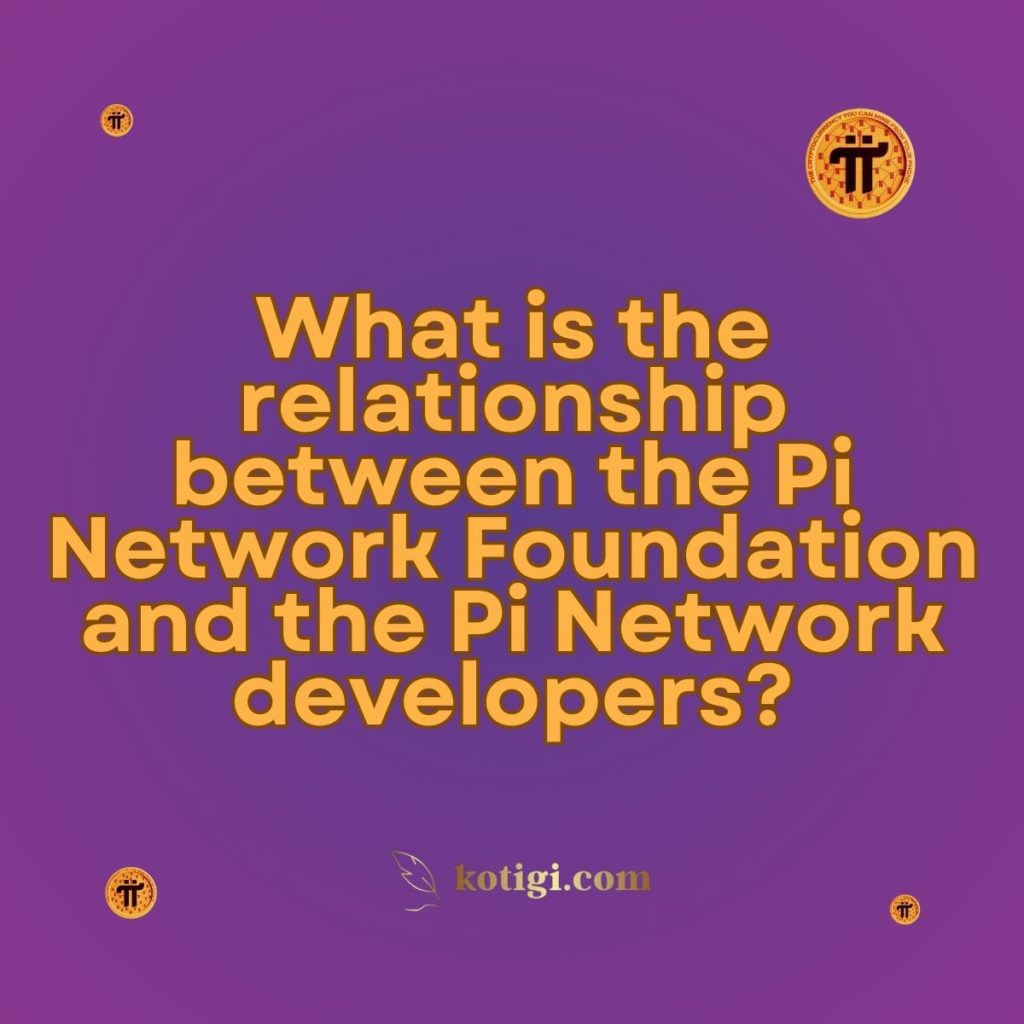
What is the relationship between the Pi Network Foundation and the Pi Network developers?
The Pi Network Foundation and Pi Network developers share a close relationship, working together to build, improve, and maintain the Pi ecosystem. The Foundation oversees the project’s mission, governance, and legal aspects, while the developers focus on technical development, ensuring the network’s security, scalability, and functionality. This collaboration ensures the network’s growth and sustainability, providing Pioneers (users) with a reliable and decentralized platform.
Introduction
The Pi Network has gained significant attention as a decentralized cryptocurrency platform that allows users to mine Pi coins directly from their mobile devices. This innovative approach to cryptocurrency mining has attracted millions of users, also known as Pioneers, who are keen to participate in what could potentially become the next big cryptocurrency. However, one of the most common questions that arise is: What is the relationship between the Pi Network Foundation and its developers? Understanding this relationship is crucial for anyone who wants to know how the Pi Network functions, who controls it, and how decisions are made within the ecosystem. The Foundation and the development team play different but complementary roles that drive the network forward. In this article, we’ll dive deep into the roles of both entities, exploring their responsibilities and how they interact to shape Pi Network’s future. By the end, you’ll have a clearer understanding of how the Pi Network is governed and maintained.
The Role of the Pi Network Foundation
The Pi Network Foundation is the central authority overseeing the project’s strategic direction, governance, and long-term goals. Unlike other cryptocurrency platforms that might rely solely on their development teams or community consensus for decision-making, Pi Network has a dedicated foundation that ensures the sustainability and ethical alignment of the platform with its original mission. The Foundation’s role is broad and encompasses many responsibilities that go beyond mere governance, including regulatory compliance, financial oversight, and ensuring that Pi Network remains decentralized and community-driven.
Governance and Vision
At its core, the Pi Network Foundation is responsible for setting the vision and long-term goals of the platform. The Foundation establishes the network’s mission, ensuring that it adheres to the principles of decentralization, community engagement, and inclusivity. The Foundation decides on the trajectory of Pi Network’s development, and it plays a vital role in maintaining the decentralized nature of the platform. It acts as the custodian of the project’s values and principles, guiding the network’s evolution to ensure that it remains aligned with the interests of the global Pi community. By laying out a clear roadmap, the Foundation helps Pioneers understand what they can expect from the project and how it will grow in the coming years.
Legal and Regulatory Compliance
In the ever-evolving cryptocurrency landscape, legal and regulatory compliance is critical. The Pi Network Foundation takes on the responsibility of ensuring that the network adheres to the relevant laws and regulations in various jurisdictions around the world. This includes working with legal experts to ensure that Pi Network is not operating in legal gray areas, particularly when it comes to matters such as data protection, anti-money laundering (AML) laws, and know-your-customer (KYC) requirements. By staying ahead of regulatory developments, the Foundation helps to protect the network from potential shutdowns or legal challenges, ensuring that Pi remains a sustainable and trustworthy project for its users.
Financial Oversight
Managing the financial resources that sustain the Pi Network is another key responsibility of the Foundation. As the governing body, the Foundation is tasked with overseeing how funds are allocated across various aspects of the project, including development, marketing, and community-building efforts. It ensures that resources are used efficiently and effectively, supporting the long-term sustainability of the platform. Additionally, the Foundation monitors the financial health of the project and manages any revenue generated from future monetization strategies, ensuring that all financial activities are transparent and align with the project’s decentralized ethos.
Who Are the Pi Network Developers?
While the Pi Network Foundation sets the vision, the Pi Network developers are the ones who turn that vision into a functional, secure, and scalable platform. The developers are a highly skilled technical team, including blockchain engineers, software developers, and cybersecurity experts, who work tirelessly to ensure the Pi Network’s technical infrastructure can support its growing user base. Their role goes beyond simply coding the platform—they are also responsible for implementing new features, maintaining security protocols, and ensuring that the network operates smoothly.
Core Development Team
The core development team of Pi Network consists of a group of highly skilled engineers and blockchain experts. These individuals have a deep understanding of blockchain technology and its potential to disrupt traditional financial systems. The team is responsible for building the foundational layers of the Pi Network’s blockchain, ensuring it is both secure and scalable. They work to create a decentralized ledger that can process transactions efficiently while maintaining the integrity and security of the network. By focusing on the technical backbone of the Pi Network, the developers play a crucial role in making the platform functional and reliable for its millions of users.
Security and Network Maintenance
Security is a top priority for any blockchain project, and the Pi Network developers are no exception. The development team continually monitors the network for potential vulnerabilities and implements security patches as needed. They are also responsible for maintaining the overall health of the network, ensuring that it runs smoothly without any downtime or disruptions. By using advanced cryptographic techniques, the developers ensure that the Pi Network remains resilient against hacking attempts, fraud, and other security threats. Their efforts are crucial for maintaining user trust and ensuring that the platform is secure enough for widespread adoption.
Features and Upgrades
As Pi Network grows, the developers are constantly working on new features and upgrades to improve the user experience and enhance the platform’s functionality. This includes implementing new ways for users to interact with the network, optimizing the user interface, and integrating decentralized applications (dApps) that can run on the Pi Network blockchain. The development team is always looking for ways to push the boundaries of what the platform can achieve, whether it’s through better transaction processing speeds, enhanced scalability, or new blockchain-based services that add value to the Pi ecosystem.
How the Pi Network Foundation and Developers Collaborate?
Collaboration between the Pi Network Foundation and its developers is essential for the platform’s success. While the Foundation sets the strategic direction, it is the developers who have the technical expertise to make those strategies a reality. The relationship between these two entities is one of constant communication and alignment, ensuring that both the governance and technical aspects of the platform work in harmony. This collaboration is key to maintaining Pi Network’s stability, security, and growth.
Strategic Alignment
The Pi Network Foundation and its developers share a common goal: to create a decentralized, user-friendly cryptocurrency that can be easily adopted by the masses. To ensure that the development efforts are aligned with the Foundation’s vision, regular communication and strategic meetings are held. These meetings allow both parties to discuss upcoming features, address any potential issues, and align on future plans for the network. By working closely together, the Foundation and the developers can ensure that the platform remains on track to achieve its long-term goals.
Innovation and Growth
While the Foundation focuses on setting strategic objectives, the developers are responsible for finding innovative ways to achieve those objectives. This collaborative dynamic fosters innovation, as developers are encouraged to propose new ideas and solutions to technical challenges. The Foundation, in turn, evaluates these proposals based on how well they align with the overall vision for the platform. Together, the two entities drive the continuous growth of the Pi Network, ensuring that it remains competitive in the rapidly evolving cryptocurrency space.
User Feedback and Adjustments
User feedback is a critical component of Pi Network’s development process. Both the Foundation and the developers are committed to creating a platform that meets the needs of its users. The Foundation gathers feedback from the community, while the developers work to implement necessary changes based on that feedback. This iterative process allows the platform to evolve in response to user needs, ensuring that Pi Network remains user-friendly and relevant as it grows.
Decision-Making Process: Who Has the Final Say?
One of the key aspects of the relationship between the Pi Network Foundation and the developers is how decisions are made. While both entities work collaboratively, each has distinct areas of authority, with the Foundation holding the final say on governance and developers leading technical decisions.
Governance and Leadership
The Pi Network Foundation retains ultimate control over major governance decisions, such as changes to the network’s core values, updates to the platform’s mission, or any significant shifts in strategy. These decisions are made with the input of the development team but are ultimately the responsibility of the Foundation. This ensures that the platform remains aligned with its original mission of creating a decentralized, inclusive cryptocurrency for the masses.
Open Communication Channels
Despite the clear delineation of roles, there is a strong emphasis on open communication between the Foundation and the developers. Both parties are encouraged to share ideas, raise concerns, and provide input on important decisions. This collaborative approach helps to ensure that decisions are well-informed and take into account both governance and technical perspectives. By fostering a culture of transparency and communication, the Pi Network ensures that decisions are not made in silos, but with the input and expertise of all stakeholders.
Conflict Resolution
In cases where disagreements arise between the Foundation and the developers, both parties have established conflict resolution mechanisms to ensure that the network’s stability is not compromised. These mechanisms prioritize the long-term success of the platform and the well-being of its users over individual preferences. By focusing on what is best for the network, the Foundation and developers can resolve conflicts in a way that ensures the continued growth and success of Pi Network.
Challenges in the Relationship
As with any complex project, the relationship between the Pi Network Foundation and its developers is not without its challenges. However, addressing these challenges head-on is crucial for ensuring the long-term success of the platform.
Balancing Vision with Practicality
One of the primary challenges in the relationship between the Foundation and the developers is balancing the Foundation’s ambitious vision with the technical realities of implementation. While the Foundation may set high-level goals for the platform, the developers must ensure that these goals are feasible from a technical standpoint. This can sometimes lead to tension, as developers may need to push back on certain timelines or expectations to ensure that the platform remains stable and secure.
Regulatory Constraints
Another challenge arises from the need to navigate an increasingly complex regulatory environment. As the Pi Network Foundation works to ensure that the platform remains compliant with global regulations, the developers must often adapt their technical plans to accommodate these legal requirements. This can slow down the development process, as the team may need to pause or modify certain features to ensure compliance.
Scaling the Network
As Pi Network’s user base continues to grow, scaling the platform to meet the needs of millions of users is a significant challenge. Both the Foundation and the developers must work together to ensure that the network can handle increased demand without sacrificing performance or security. This requires careful planning and ongoing collaboration between the two entities to ensure that the network remains efficient and reliable.
Conclusion
The relationship between the Pi Network Foundation and its developers is one of mutual dependence and collaboration, with both entities playing critical roles in the platform’s success. The Foundation provides governance, strategic direction, and legal oversight, while the developers bring the technical expertise needed to build and maintain the network. Together, they ensure that Pi Network remains secure, scalable, and aligned with its mission of creating a decentralized cryptocurrency for everyday users. As the network continues to grow, this collaborative relationship will be crucial in ensuring its long-term sustainability and success.
Key Takeaways
- The Pi Network Foundation oversees governance, compliance, and financial management, ensuring the network’s long-term vision.
- Developers focus on building, maintaining, and securing the Pi Network’s technical infrastructure.
- Collaboration between the Foundation and developers ensures that the platform remains aligned with its strategic goals while remaining technically sound.
- The decision-making process involves input from both sides, with the Foundation taking the lead on governance decisions and developers handling technical implementations.
- Addressing challenges such as scalability, regulatory constraints, and balancing vision with practicality is key to ensuring Pi Network’s continued success.





